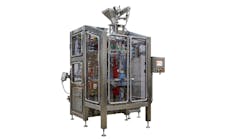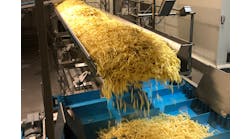Today on the podcast, we’re talking with Jeff Broussard, president of EnSight Solutions. Jeff joins us to talk about further processing, a topic EnSight has a lot of knowledge on.
In the episode, Jeff talks us through what further processing is and what trends he’s seeing in the processing market. He walks us through developments in further processing equipment design before offering insights on what it means to be a trusted partner for food processors.
Food Processing: Jeff, welcome to the Food for Thought podcast. Talk to me about further processing. What does that mean to EnSight?
Jeff Broussard: That's a good question. Further processing to us is really everything that happens between the beginning of the process to the end of the process. And so what do I mean by that? If we were going to take chicken for example, and let's say we were going to tenderize a chicken breast in that process, there's going to be some processes that get that chicken breast aligned and ready to go through that. What we're talking about is the chicken, the raw chicken breast, before it goes in does the further processing, which is what we call tenderizing or slicing or marinating, whatever's going to happen to that chicken breast, and then it goes out and it is now the final product. That process is what we call further processing, and that can be myriad of things. Any of your proteins – can be anything from dairy, could be some bakery items even – the further processing is those areas where it comes in as one thing, goes through a process, and it comes out of something else.
FP: Can you tell me what you're seeing in the processing market?
JB: Absolutely. I think the biggest thing that has jumped off the page to us in the last couple years has been the reduction in labor. Everybody is struggling with labor, trying to keep people on the lines, trying to keep their lines up and running, trying to get products in case form and out the door to their customers. I think our biggest scenario is the amount of turnover and the training that's necessary with the people who are on the line running the equipment. It's been a real big challenge for our customers and so they've really honed in and said, "Hey, we really want something that's simple. We want it to be simple. We want it to be repeatable. We want it to have a good hygienic design so we're not spending exorbitant amount of time cleaning it, but it really needs to operate simply." We've tried to hone in on that. That's probably been the biggest scenario is trying to increase the automation, if you will, of the process as well as making it simple for our customers to utilize in that application. Those are the two biggest things that have jumped out to us lately.
FP: Tell me more about some of the developments in further processing equipment design.
JB: That's a great question as well. I think years before, we kind of alluded to the labor shortage today, years before, it wasn't that big of a deal to have multiple processes in a line. They may take one element, one protein, and it may have two or three different functions that happen to it before it actually gets to what's considered the finished product. Today they're trying to make some of those processes multi-function and they're trying to be able to get more product done with the certain type of equipment than what they have in the past. An easy to use, multi-function equipment is something that we're starting to see more and more of.
Like I mentioned earlier too, on the operator side, we really need it to be simple. Another thing that we've seen development-wise is really bringing controls into the market. When I say controls, we have something that's called an HMI, which is a human interface item, between the operator and the machine, it needs to be very simple. It needs to be consistent, easy and simple, very intuitive, kind of like your phone today. You want to be able to have anybody walk up to the screen and be able to hit the button and know what the end result is going to be. Those are some of the areas that we've really focused on and really have seen developments in.
Then the last one that's probably maybe a bigger encompassing component of that is really that multi-function/all the way to automation. Customers are wanting to be able to take people off the line to reallocate them into higher demanding areas somewhere in their business, and so anytime we can automate a process and be able to connect that with some of our equipment on the front end or even on the back end, it just makes that process a lot easier to operate and manage. It allows our customer to be able to re-utilize that labor. Those are some of the biggest key developments we've seen.
FP: What does it mean to you to be a trusted partner for food processors?
JB: I personally love that question. We use that a lot in here internally from our own dialogues is what does it really mean to be a trusted partner? I think if you take it to your own personal level, if you're going to go out and buy something, you want somebody to be there right there with you that you can rely on, somebody that you feel comfortable with in that process. If you're going to buy a car or something, you don't want to just buy it from somebody that you don't trust. You want to buy it from somebody that you feel like really has your interest in mind.
I think, so from us, per se, when we want to align with our customers, we really want to be there from the thought partner component, from the very beginning part of it, all the way through the design, the engineering, the fabrication of it, and really to the service position, to be able to make sure that the customer can utilize the equipment or the entire line that we've provided them. When we consider trusted partner internally, we really want to be somebody that our customer wants to rely on and to lean up against so that we can work together to accomplish the similar goal, which ultimately for them is usually to get their production line up and running. For me, it's from the soup to nuts, it's from the beginning all the way to the end in that whole scenario.


